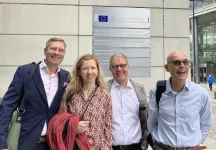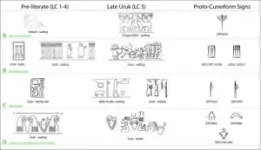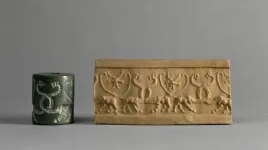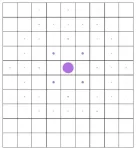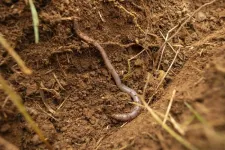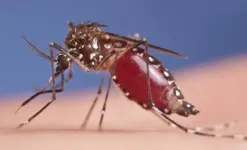(Press-News.org) The CODICUM project brings together experts in history, literature, and bio-codicology from four Nordic universities to explore medieval knowledge networks. This groundbreaking study combines traditional humanities approaches with cutting-edge biomolecular analysis of fragments from medieval books, written on animal skin.
How book culture shaped medieval Europe
The project will investigate approximately 50,000 medieval Latin book fragments preserved in Nordic collections—one of Europe’s largest archives of medieval book culture.
"These fragments represent an extraordinary treasure trove that can transform our understanding of how books and ideas circulated in medieval Europe," Professor Åslaug Ommundsen says. "With this funding we will be able to lift fragment studies to a new level and dramatically increase our knowledge about medieval books and how the Nordic region became part of a pan-european book culture."
Medieval books played a vital role in shaping European history, carrying rituals, stories, and ideas as they were read, copied, and shared across regions. Today, they offer scholars insights into historical trade, craftsmanship, and the religious, social, and intellectual networks that connected Europe. Less than 10% of the European manuscript corpus survives, with an even smaller fraction in Scandinavia.
How binding materials accidentally saved thousands of medieval books
"While most medieval manuscripts in the Nordic countries were destroyed or lost after the Reformation, their leaves were often recycled as binding material for administrative documents. This practice accidentally preserved evidence of thousands of books, most of them Latin books used in churches, and often originating from other parts of Europe," Professor Ommundsen says.
A unique feature of this project is the use of new techniques to trace the geographic origins of manuscript materials and identify previously unknown connections between religious and intellectual centres.
Combining classic humanities with cutting-edge biomolecular analysis
"Using biomolecular methods, we can now extract DNA and protein information from parchment to determine where animals were raised and how manuscripts were produced," Professor Matthew Collins says.
"The fragments are challenging us to rethink how we define 'textual heritage'. Rather than belonging to individual nations, these manuscripts reveal a shared European literary heritage that transcended medieval borders,” says Professor Lars Boje Mortensen.
"By analysing both the texts and materials of these fragments, we hope to unlock a new understanding of how Northern Europe was integrated into broader European intellectual culture," adds Professor Tuomas Heikkilä.
The CODICUM project
The Medieval Book and Networks of Northern Europe c. 1000-1500: Texts, Crafts, Fragments (CODICUM)
Principal investigators:
Professor Åslaug Ommundsen, University of Bergen - Palaeography
Professor Tuomas Heikkilä, University of Helsinki - History
Professor Lars Boje Mortensen, University of Southern Denmark - Literature
Professor Matthew Collins, University of Copenhagen - Bio-codicology
The National Archives in Stockholm and the Royal Library in Copenhagen, are also partners in the project.
Funding: ERC Synergy Grant, around 13 million euro, for 2025-2030, announced by the ERC today.
END
Nordic research team receives €13 million to explore medieval book culture
The team i awarded an ERC Synergy Grant to investigate how books and literary networks shaped Northern Europe between 1000 and 1500 CE.
2024-11-05
ELSE PRESS RELEASES FROM THIS DATE:
The origin of writing in Mesopotamia is tied to designs engraved on ancient cylinder seals
2024-11-05
The origins of writing in Mesopotamia lie in the images imprinted by ancient cylinder seals on clay tablets and other artifacts. A research group from the University of Bologna has identified a series of correlations between the designs engraved on these cylinders, dating back around six thousand years, and some of the signs in the proto-cuneiform script that emerged in the city of Uruk, located in what is now southern Iraq, around 3000 BCE.
The study—published in Antiquity—opens new perspectives on ...
Explaining science through dance
2024-11-05
Science can be difficult to explain to the public. In fact, any subfield of science can be difficult to explain to another scientist who studies in a different area. Explaining a theoretical science concept to high school students requires a new way of thinking altogether.
This is precisely what researchers at the University of California San Diego did when they orchestrated a dance with high school students at Orange Glen High School in Escondido as a way to explain topological insulators.
The experiment, led by former graduate student Matthew Du and UC San Diego Associate Professor of Chemistry and Biochemistry Joel Yuen-Zhou, was published in Science Advances.
“I ...
Pioneering neuroendocrinologist's century of discovery launches major scientific tribute series
2024-11-05
Tucson, Arizona, 5 November 2024 – Brain Medicine has launched an ambitious Festschrift series with the first of more than ten planned articles celebrating Dr. Seymour Reichlin's centennial year and his transformative impact on neuroendocrinology. The opening editorial, chronicling his revolutionary insights into brain-hormone interactions, inaugurates what promises to be one of the most comprehensive tributes in the field's history.
“One could be both a physician caring for patients and a scientific investigator,” reflects Dr. Reichlin, whose work spanning nearly 80 years has fundamentally reshaped our understanding of how ...
Gendered bilingualism in post-colonial Korea
2024-11-05
In the 1960s, Japanese books became immensely popular in South Korea. Interestingly, Korean newspapers often wrote about this trend as if mainly women were interested in learning Japanese.
Osaka Metropolitan University Associate Professor Jinsuk Yang examined South Korean newspaper articles and other historical documents from the 1960s and 1970s to understand why Japanese language learning was often described as something women did, even though men were also learning Japanese. Additionally, Professor Yang studied how women’s ability to speak Japanese affected ...
Structural safety monitoring of buildings with color variations
2024-11-05
As buildings age, the demand for effective monitoring of their structural integrity has grown significantly. A breakthrough in nano-optical sensor technology now enables precise, real-time measurement of structural deformation and stability. This innovation promises to reshape the field of structural diagnostics, offering a cost-effective, time-efficient solution that reduces the need for specialized expertise traditionally required in this area.
Led by Dr. Jae Sung Yoon, Principal Researcher at the Nano-lithography & Manufacturing Research Center within the Nano-convergence ...
Bio-based fibers could pose greater threat to the environment than conventional plastics
2024-11-05
Bio-based materials may pose a greater health risk to some of the planet’s most important species than the conventional plastics they are designed to replace, a new study has shown.
Such materials are increasingly being advocated as environmentally friendly alternatives to plastics, and used in textiles and products including clothing, wet wipes and period products.
However, microfibres of the materials are emitted into the environment through the laundry cycle, the application of sewage sludge as fertilisers, or the simple wear and tear of textile products.
Despite increasing quantities of bio-based products being produced and sold all over the world, there has been ...
Bacteria breakthrough could accelerate mosquito control schemes
2024-11-05
Mosquito larvae grow faster if they’re exposed to particular bacteria, according to a new study that could help global health programmes.
Aedes aegypti mosquitoes spread illnesses including dengue, yellow fever and Zika.
Anti-disease programmes breed and release non-biting male mosquitoes that are either sterile or prevent transmission of diseases.
These mass release programmes can be substantially more effective than the widespread spraying of insecticides, as these insects have developed resistance to many commonly employed chemicals.
The new study, by ...
Argonne to help drive AI revolution in astronomy with new institute led by Northwestern University
2024-11-04
The U.S. National Science Foundation and Simons Foundation have selected a group of institutions, including Argonne, to receive funding to establish an AI and astronomy institute called the NSF-Simons AI Institute for the Sky (SkAI).
Part of a groundbreaking effort to harness artificial intelligence (AI) to unlock the mysteries of the cosmos, the U.S. Department of Energy’s (DOE) Argonne National Laboratory is a key collaborator in the newly launched NSF-Simons AI Institute ...
Medicaid funding for addiction treatment hasn’t curbed overdose deaths
2024-11-04
For generations, the federal government has largely refrained from paying for mental health and substance use treatment in large residential facilities.
That changed in 2015 when, in response to increasing overdose deaths nationwide from illicit drugs, the federal government allowed states to waive a longstanding prohibition against using federal Medicaid funding for services in so-called institutions of mental diseases. In turn, states were required to improve their addiction care with an emphasis on increasing treatment with medications.
Yet a new study by researchers at Oregon Health & Science University finds no overall ...
UVA co-leads $2.9 million NIH investigation into where systems may fail people with disabilities
2024-11-04
A University of Virginia School of Engineering and Applied Science researcher is partnering on a historic and foundational National Institutes of Health study to help the nation discuss, and better address, the concept of structural ableism and where it may result in healthcare disparities.
Rupa Valdez, a professor of systems and information engineering who also holds an appointment as a professor of public health sciences in the UVA School of Medicine, is co-leading the five-year, $2.9 million investigation — the first of its kind.
Currently, the field relies on non-standardized ...
LAST 30 PRESS RELEASES:
Neuroscientists devise formulas to measure multilingualism
New prostate cancer trial seeks to reduce toxicity without sacrificing efficacy
Geometry shapes life
A CRISPR screen reveals many previously unrecognized genes required for brain development and a new neurodevelopmental disorder
Hot flush treatment has anti-breast cancer activity, study finds
Securing AI systems against growing cybersecurity threats
Longest observation of an active solar region
Why nail-biting, procrastination and other self-sabotaging behaviors are rooted in survival instincts
Regional variations in mechanical properties of porcine leptomeninges
Artificial empathy in therapy and healthcare: advancements in interpersonal interaction technologies
Why some brains switch gears more efficiently than others
UVA’s Jundong Li wins ICDM’S 2025 Tao Li Award for data mining, machine learning
UVA’s low-power, high-performance computer power player Mircea Stan earns National Academy of Inventors fellowship
Not playing by the rules: USU researcher explores filamentous algae dynamics in rivers
Do our body clocks influence our risk of dementia?
Anthropologists offer new evidence of bipedalism in long-debated fossil discovery
Safer receipt paper from wood
Dosage-sensitive genes suggest no whole-genome duplications in ancestral angiosperm
First ancient human herpesvirus genomes document their deep history with humans
Why Some Bacteria Survive Antibiotics and How to Stop Them - New study reveals that bacteria can survive antibiotic treatment through two fundamentally different “shutdown modes”
UCLA study links scar healing to dangerous placenta condition
CHANGE-seq-BE finds off-target changes in the genome from base editors
The Journal of Nuclear Medicine Ahead-of-Print Tip Sheet: January 2, 2026
Delayed or absent first dose of measles, mumps, and rubella vaccination
Trends in US preterm birth rates by household income and race and ethnicity
Study identifies potential biomarker linked to progression and brain inflammation in multiple sclerosis
Many mothers in Norway do not show up for postnatal check-ups
Researchers want to find out why quick clay is so unstable
Superradiant spins show teamwork at the quantum scale
Cleveland Clinic Research links tumor bacteria to immunotherapy resistance in head and neck cancer
[Press-News.org] Nordic research team receives €13 million to explore medieval book cultureThe team i awarded an ERC Synergy Grant to investigate how books and literary networks shaped Northern Europe between 1000 and 1500 CE.
